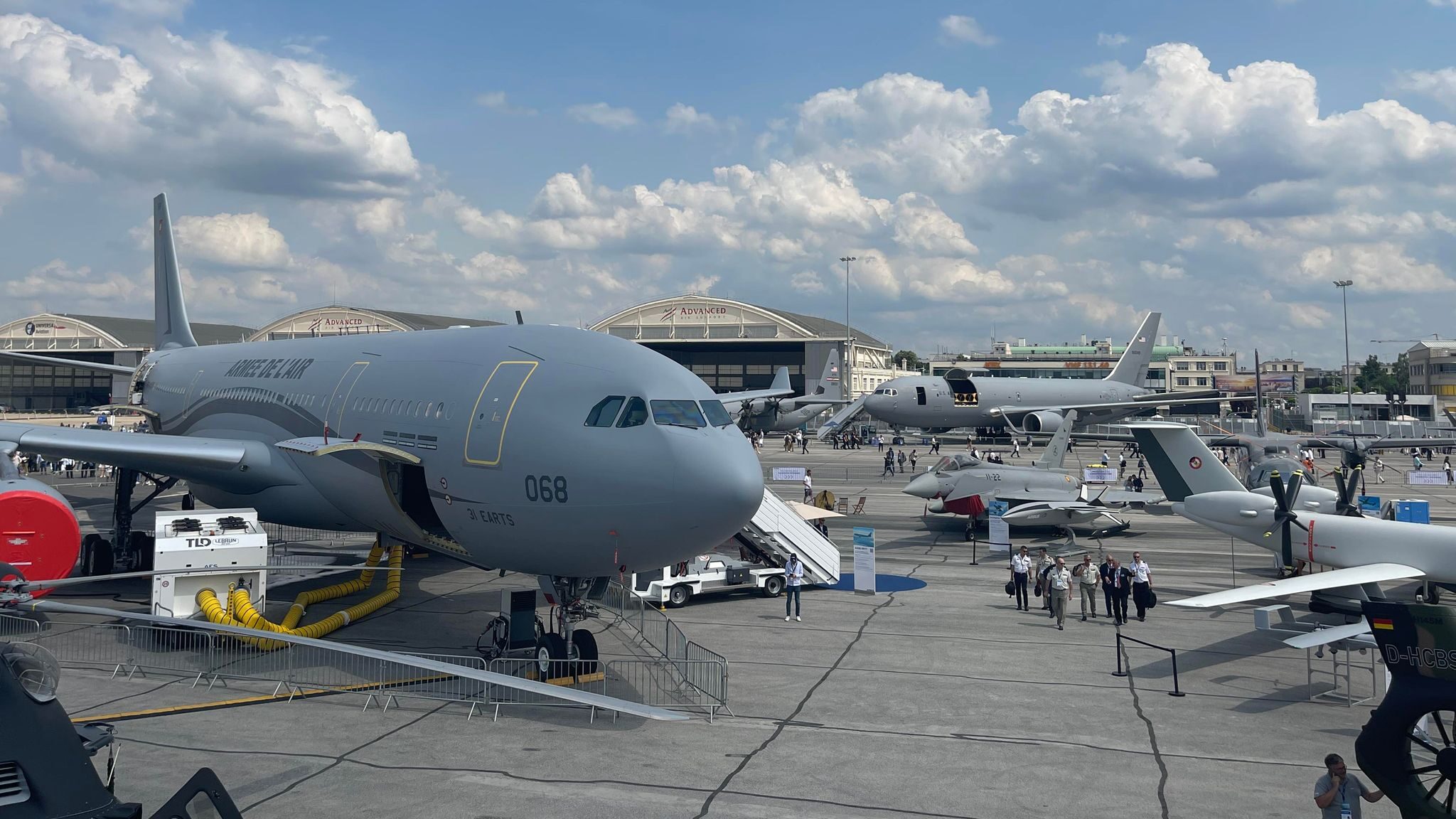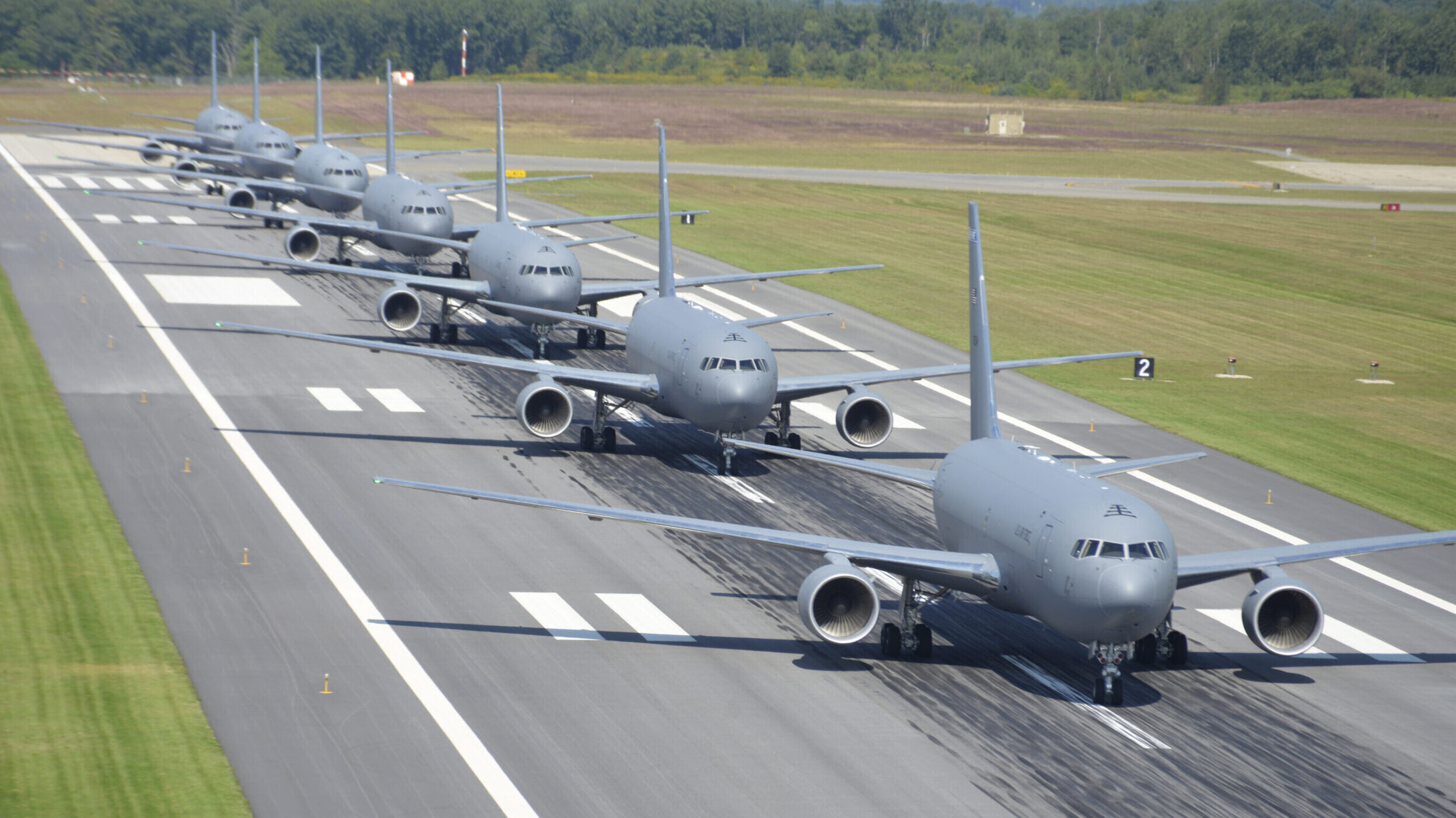
A French MRTT sits in the foreground at the Paris Air Show with Boeing’s KC-46A Pegasus seen in the background with its cargo door ajar. (Michael Marrow/Breaking Defense)
RIAT 2023 — On the tarmac at last month’s Paris Air Show, the Airbus A330 Multi-role Tanker Transport (MRTT) and Boeing KC-46A Pegasus were just yards away, perhaps symbolic positioning for the two contenders as the US Air Force weighs how to continue recapitalizing an aging fleet of KC-135 Stratotankers.
Though an Air Force official has said the service is leaning toward buying 75 more KC-46As in the near future, defense giant Lockheed Martin is betting its LMXT refueler, based on the Airbus A330 MRTT, could grab a chunk of the work before there’s a formal competition for the Air Force’s next-generation tanker.
With that potential in mind, Breaking Defense toured both platforms on the Le Bourget tarmac, and some especially interesting guests also wandered through the MRTT — an active duty Pegasus aircrew. With experience on the Boeing bird, the crew was able to offer what they saw as pros and cons about the rival tanker when compared with their Pegasus jet.
Two caveats need to be applied. First, aircrews tend to be partial to the planes they know, so there is likely a pro-Pegasus bias in play. And second, the MRTT doesn’t offer a perfect picture of LMXT, as that modified plane has its own requirements unique to the US Air Force. However, some aspects like cargo carrying, passenger comfort and boom operations would be largely identical. And as representatives of the tanking community, the KC-46A crew’s views on what matters to them were certainly interesting to hear.
Cargo Capacity, Creature Comforts
One key consideration identified by the KC-46A crew is the capacity of each tanker to ferry pallets of supplies. US Air Force Capt. Cody Nelson, who has been piloting the Pegasus for over a year, said the MRTT is a “super capable” jet, but his “personal thought” is that the KC-46A offers more military utility “because of that worldwide mobility that we are a part of.”
Fully loaded with cargo, a KC-46A can carry 18 pallets, while the LMXT can only carry six pallets. Foregoing two additional pallet spaces is a trade off LMXT designers made to store an extra 25,000 pounds of gas for a total of 56,000 pounds more fuel offload over the KC-46A, according to LMXT campaign director Larry Gallogly. The KC-46A’s max fuel offload is around 212,000 pounds, an Air Force factsheet says, meaning LMXT’s rough total should be 268,000 pounds.
Still, Tech. Sgt. Jessica Harrell, a KC-46A boom operator who is dual-hatted as its cargo handler, underscored the Pegasus’s greater cargo carrying capacity when asked for her observations following a tour of the MRTT.
“The con of the MRTT, mainly for me, is the cargo. They are very limited on cargo, and that’s a huge part of our jet,” she said. “We can take a lot more cargo than them, a lot larger — they’re very limited on the confinements of their underbelly. So that’s huge, I think, for the Air Force as a whole.”
Lockheed officials have stated that the LMXT is not seeking to exactly replicate the roles filled by the KC-46A, hence the emphasis on loading up as much gas on the tanker as possible. As part of that logic, the company is pitching a specialized battle management station for the tanker as the Air Force separately develops an edge node capability for the Pegasus.
Perhaps less important to the Air Force when it comes to deciding which way to go with its tanker fleet, but not so for people who actually fly and ride on the planes, is just how comfortable they are. In this instance, Nelson seemed to give the MRTT/LMXT the edge.
“I’d say comfort for the passengers would be the biggest thing,” Nelson said when asked about the pros and cons between a more commercial-like configuration for the MRTT and the more militarized interior of the KC-46A, which is derived from Boeing’s 767 commercial jetliner. “I’m sure some people would like to see out the side windows, which we don’t have that many of.”

KC-46A aircraft assigned to the 157th Air Refueling Wing perform an elephant walk formation on the runway at Pease Air National Guard Base, Sept. 8, 2021. (U.S. Air National Guard Photo by Senior Master Sgt. Timm Huffman)
Cockpit Compatriots
Speaking with Breaking Defense from the cockpit of the Pegasus parked on the Le Bourget tarmac, Nelson downplayed the high-profile woes that have prompted a full overhaul of the tanker’s Remote Vision System (RVS), which the Air Force and Boeing expect to deliver in October 2025.
Even with the deficient RVS, “I’ve never had a boom operator not be able to give fuel to someone,” Nelson said. Bright sunlight that can wash out the RVS cameras is also not exactly new — similar problems have impacted manually-operated refueling missions on jets like the KC-10 and KC-135, Nelson pointed out, due to canopy glare from a receiving aircraft like an F-35 that could blind a boom operator.
“And so what would the pilots do?” he asked. “Hey, turn one degree to the left, and now we’re good.”
RELATED: Rep. Wittman on F-35 engine upgrade, KC-46 concerns and which USAF plane’s ‘time is done’
To be sure, RVS promised deliverance from issues like these that seemingly do not bedevil the MRTT’s increasingly automated vision system, though Nelson described the operational impact of current RVS shortcomings as marginal. (For its part, Boeing is also testing out automatic refueling capabilities for the Pegasus that could be incorporated in future upgrades.)
Likewise, Harrell said, “I don’t have any issues with it.” A former KC-135 boom operator, Harrell said remote vision systems like those on the KC-46A and MRTT are much easier on the body, and noted that some small adjustments are sufficient to overcome hurdles for the former’s RVS.
“I’ve never had an issue with glare. There’s different settings on the cameras, different things you can do to make the view possible,” such as “turn[ing]” the jet to get out of the sunlight, she said.
Harrell has personally seen the RVS overhaul in the works, and though she underscored she “100 percent” has what she needs to perform her job, she stated she was looking forward to the color and texture improvements offered by the forthcoming RVS overhaul.
System issues aside, the crew did weigh in on different design choices between the Pegasus’s and the MRTT’s mid-air refueling setup. In the KC-46A, the boom operator’s station is just outside the cockpit in its own section, while in the MRTT, the boom operator sits with the jet’s pilots in the cockpit. That proximity in the MRTT/LMXT may not be necessarily a good thing, Nelson suggested.
“If we’re doing air-to-air refueling, and I’m talking on three different radios, it’s nice to have quiet,” Nelson said.
Harrell too said she liked “to have the quiet while I’m working,” adding that having to share space with pilots during refueling runs could “kind of get distracting.” But she also said other crew members liked the idea of being able to turn around and talk to pilots and both said their comments stem from personal preference.
Noting there are pros and cons for any configuration, LMXT campaign manager Ken Moss pointed to benefits like “facilitat[ing] crew coordination without requiring intercoms” and that “While constant radio chatter from the pilots may be a nuisance, this can be solved through the use of headsets as needed.”
In the end, Harrell suggested that though the plane designs did have their differences, neither was dramatically better.
“I think our jets are so similar that it would kind of be the same, having their jet,” she said.






















